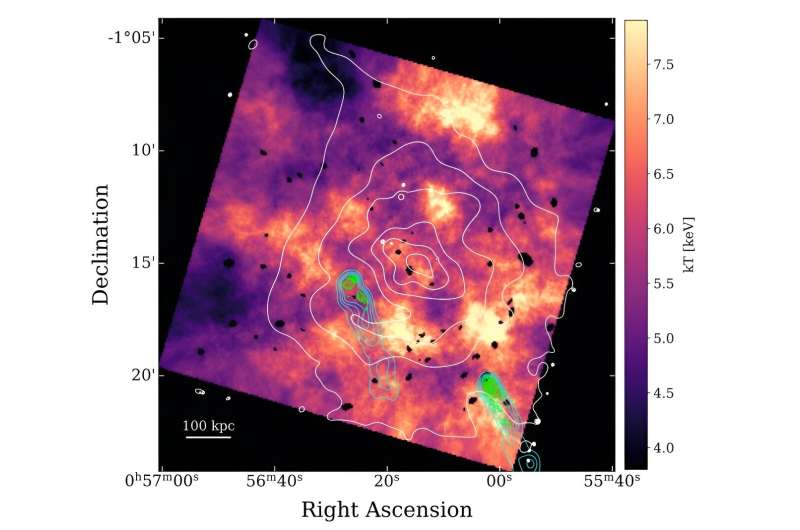August 17, 2023 report
This article has been reviewed according to Science X's editorial process and policies. Editors have highlighted the following attributes while ensuring the content's credibility:
fact-checked
preprint
trusted source
proofread
Complex galaxy cluster Abell 119 explored by researchers

Using NASA's Chandra spacecraft, astronomers have performed detailed X-ray observations of a complex galaxy cluster known as Abell 119. Results of the observational campaign, published August 9 on the pre-print server arXiv, shed more light on the properties and nature of this cluster.
Galaxy clusters contain up to thousands of galaxies bound together by gravity. They are the largest known gravitationally bound structures in the universe, and could serve as excellent laboratories for studying galaxy evolution and cosmology.
At a redshift of 0.044, Abell 119 (or A119 for short) is a large galaxy cluster containing about 70 member galaxies. It hosts two narrow-angle tail (NAT) radio sources and its brightest cluster galaxy (BCG) is UGC 579. Previous observations have found that Abell 119 is a dynamically complex cluster with multiple substructures.
A group of astronomers led by Courtney B. Watson of Boston University decided to investigate Abell 119 with Chandra in order to get more insights into its properties. The study was complemented by data from ground-based observatories.
The observational campaign of Abell 119 found that the overall X-ray emission from the intracluster medium (ICM) is fairly asymmetric with an elongation to the northeast, resulting in a "teardrop" shape. Moreover, the adaptively smoothed X-ray image shows the possible presence of clumpy substructure within the ICM.
The astronomers identified two two cold fronts (CF1 and CF2) that could be connected to form a sloshing spiral structure, which may be a result of an off-axis merger. This sloshing spiral structure could correspond to the elongated teardrop-shaped X-ray emission seen in the northeast direction.
The observations detected a shock front located about 250 arcseconds from the cluster's core and just outside of the potential sloshing cold front. The shock has a Mach number of 1.21 and its velocity is estimated to be 1,530 km/s, what is consistent with a merger shock.
The study also found evidence of Abell 119's galaxies forming a filamentary structure which extends nearly 26 million light years to the north-northeast direction, which appears to connect Abell 119 to another galaxy cluster—Abell 116.
Summing up the results, the authors of the paper underlined that Abell 119 is a fairly complex system, with a potential sloshing spiral, a merger shock, and possible connection with a neighboring cluster through large-scale filamentary structures. They added that their observations provide evidence of a recent or ongoing merger.
"Our results show alignment of the elongated X-ray emission, the optical substructures, and the flow directions of the radio jets/lobes of both NATs. This, with the comparison to simulations, all supports our picture of recent or on-going merger activity occurring in the NE-SW direction," the researchers concluded.
More information: Courtney B. Watson et al, Chandra X-Ray Observations of Abell 119: Cold Fronts And A Shock In An Evolved Off-Axis Merger, arXiv (2023). DOI: 10.48550/arxiv.2308.04367
Journal information: arXiv
© 2023 Science X Network





















